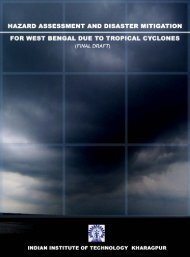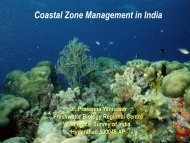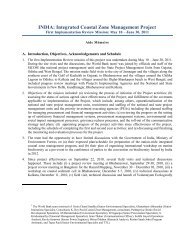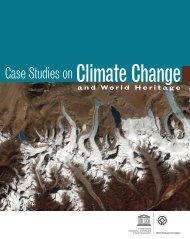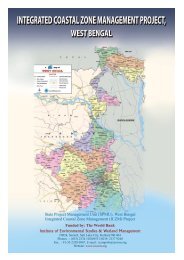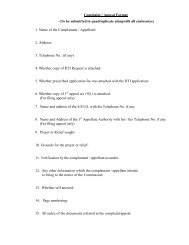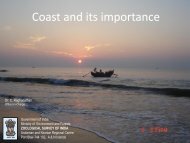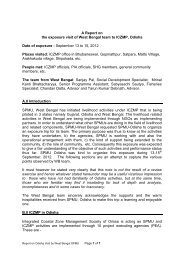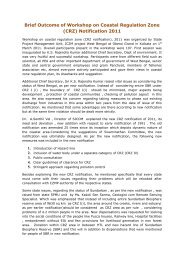Climate change adaptation in coastal region of West ... - WWF-India
Climate change adaptation in coastal region of West ... - WWF-India
Climate change adaptation in coastal region of West ... - WWF-India
Create successful ePaper yourself
Turn your PDF publications into a flip-book with our unique Google optimized e-Paper software.
<strong>Climate</strong> Change Policy Paper II<br />
<strong>Climate</strong> Change Adaptation <strong>in</strong><br />
Coastal Region <strong>of</strong> <strong>West</strong> Bengal<br />
Sugata Hazra
The 7516 km long coastl<strong>in</strong>e <strong>of</strong> <strong>India</strong> and associated <strong>coastal</strong><br />
zones are extremely vulnerable to climate <strong>change</strong> <strong>in</strong>duced<br />
fast and slow onset disasters. Every year, loss <strong>of</strong> life and<br />
property <strong>in</strong> the <strong>coastal</strong> areas are <strong>in</strong>creas<strong>in</strong>g due to high<br />
<strong>in</strong>tensity cyclones, floods, <strong>change</strong> <strong>in</strong> ra<strong>in</strong>fall pattern, cloud<br />
burst, sal<strong>in</strong>e water <strong>in</strong>gression and <strong>coastal</strong> erosion due to<br />
accelerated sea level rise.<br />
In the year 2009, the severe cyclone 'Aila' hit the State <strong>of</strong><br />
<strong>West</strong> Bengal with 120km/hr w<strong>in</strong>d speed and around 2m high<br />
storm surge, devastat<strong>in</strong>g extensive areas <strong>of</strong> <strong>coastal</strong><br />
Sundarban kill<strong>in</strong>g people and flood<strong>in</strong>g agriculture fields by<br />
sal<strong>in</strong>e water. Later, we were hit by drought though we had a<br />
forecast from <strong>of</strong>ficial agencies <strong>of</strong> healthy and timely<br />
monsoon. Due to concentrated ra<strong>in</strong>fall dur<strong>in</strong>g post monsoon<br />
months (which keeps the statistics <strong>of</strong> yearly average ra<strong>in</strong>fall<br />
close to 'normal') we had extensive floods, <strong>in</strong> Andhra, Goa,<br />
Karnataka and <strong>in</strong> parts <strong>of</strong> <strong>West</strong> Bengal and Assam.<br />
Additionally, the <strong>in</strong>creased population pressure and<br />
economic activity <strong>in</strong> <strong>coastal</strong> zones are magnify<strong>in</strong>g the<br />
extent <strong>of</strong> <strong>coastal</strong> disasters.<br />
An estimate suggests that <strong>in</strong> <strong>India</strong>, nearly 2000 lives are lost<br />
every year due to floods, cyclone and heavy ra<strong>in</strong>. However,<br />
few <strong>coastal</strong> states <strong>in</strong> <strong>India</strong> have an <strong>in</strong>tegrated <strong>coastal</strong> zone<br />
management plan, although none <strong>of</strong> those that do, have so<br />
far been able to l<strong>in</strong>k it with a disaster management plan or<br />
the national action plan on climate <strong>change</strong>. The attitude so far<br />
has been and still is, to focus more on reactive relief and postdisaster<br />
activity than on more responsive disaster<br />
preparedness or risk management. Institutionally and<br />
otherwise we are not yet ready to accept that the climate is<br />
chang<strong>in</strong>g, and chang<strong>in</strong>g faster than anticipated. We are <strong>of</strong>ten<br />
confused between 'short term' climate variability (e.g.rate <strong>of</strong><br />
retreat <strong>of</strong> Gangotri has been slower for the last three years!)<br />
and long term <strong>change</strong>s <strong>in</strong> the climate <strong>of</strong> the world. It is high<br />
time to adopt a more scientific method <strong>of</strong> risk assessment<br />
and evaluation and co ord<strong>in</strong>ate efforts towards risk reduction<br />
and disaster preparedness anticipated due to climate<br />
Introduction<br />
<strong>Climate</strong> Change Policy Paper II<br />
1
Coastal Region<br />
<strong>change</strong>, particularly for <strong>coastal</strong> zones.<br />
In <strong>India</strong>, we still consider react<strong>in</strong>g to 'rapid onset' natural<br />
hazards as the primary, if not the only management<br />
objective. However, the potential threats <strong>of</strong> 'slow onset'<br />
disasters like climate <strong>change</strong>, sea level rise, <strong>coastal</strong><br />
erosion/submergence and water quality degradation<br />
rema<strong>in</strong> largely unattended to. Global warm<strong>in</strong>g and sea level<br />
rise pose a serious threat to the existence <strong>of</strong> the small islands<br />
and island states throughout the world <strong>in</strong>clud<strong>in</strong>g the<br />
Sundarban island system <strong>of</strong> <strong>West</strong> Bengal. Though the<br />
absolute Sea level rise globally over the last century has<br />
been little over 20cm, locally the relative rate <strong>of</strong> rise is found<br />
to be several times more due to deltaic subsidence and<br />
siltation. With just a slight rise <strong>in</strong> sea level, <strong>of</strong>f-island<br />
migration <strong>of</strong> environmental refugees from Sundarban island<br />
system <strong>of</strong> <strong>India</strong> and Bangladesh may be anticipated. A<br />
comprehensive action plan for climate <strong>change</strong> <strong>in</strong> <strong>India</strong><br />
would be <strong>in</strong>complete without the <strong>in</strong>clusion <strong>of</strong> a def<strong>in</strong>ite<br />
mission address<strong>in</strong>g the vulnerable <strong>coastal</strong> zone, which<br />
<strong>in</strong>cludes <strong>of</strong> <strong>West</strong> Bengal, Orissa, Andamans, Andhra<br />
Pradesh, Lakshwadeep, Gujarat and others.<br />
The national action plan on climate <strong>change</strong> can def<strong>in</strong>itely be<br />
improved if we consider rate <strong>of</strong> sea level rise relative to land<br />
differently for different <strong>coastal</strong> states rather than rely<strong>in</strong>g on a<br />
1<br />
'national average' <strong>of</strong> 1.06-1.75mm/yr which fails to address<br />
the ground realities <strong>of</strong> subsid<strong>in</strong>g deltas like Sundarban.<br />
In terms <strong>of</strong> an operational policy framework, a new draft<br />
<strong>coastal</strong> management zone notification was issued by the<br />
Government <strong>of</strong> <strong>India</strong> (S.O. 1070(E) ,1.5.2008) with an aim to<br />
re-designate the <strong>coastal</strong> zone and demarcate a new 'set<br />
back l<strong>in</strong>e' as per vulnerability due to sea level rise and<br />
<strong>coastal</strong> erosion. However, this was later withdrawn mostly<br />
due to resistance from different quarters and also because it<br />
did not <strong>in</strong>dicate scientifically viable methodology for<br />
vulnerability assessment related to sea level rise and for<br />
demarcat<strong>in</strong>g a set back l<strong>in</strong>e by the local authorities. Further,<br />
the sea level trend proposed was taken as the 'global<br />
average' as suggested by IPCC, while the damage, actually<br />
tak<strong>in</strong>g place along the coast depends upon 'local' factors that<br />
controls the 'relative sea level' <strong>of</strong> the <strong>region</strong>. Thus , even at<br />
the end <strong>of</strong> 2010, we still do not have an operational policy<br />
framework for <strong>in</strong>tegrated <strong>coastal</strong> zone management, which<br />
takes <strong>in</strong>to account the problem <strong>of</strong> climate <strong>change</strong> , sea level<br />
rise, habitat loss or rehabilitation policies for 'environmental<br />
refugees' from <strong>coastal</strong> zones. Government <strong>of</strong> <strong>India</strong> formally<br />
2
Tide L<strong>in</strong>e’ or elaborat<strong>in</strong>g a methodology to del<strong>in</strong>eate the<br />
“Hazard L<strong>in</strong>e” or setback l<strong>in</strong>e necessary for <strong>coastal</strong> <strong>adaptation</strong> to<br />
,
Coastal Region<br />
Potential Temperature (K)<br />
302.4<br />
302.3<br />
302.2<br />
302.1<br />
TEMPERATURE ANOMALY<br />
302<br />
301.9<br />
301.8<br />
301.7<br />
Temperature<br />
301.6<br />
2000<br />
1<br />
0.5<br />
0<br />
-0.5<br />
-1<br />
Average Potential Temperature at surface level (1000 hP a)<br />
<strong>in</strong> the month April<br />
2001 - 2007<br />
2001<br />
2002<br />
2003<br />
2004<br />
2005<br />
2<br />
y = 0.1082x + 85.14, R = 0.973<br />
2006<br />
YEARLY VARIATION OF SURFACE AIR TEMPERATURE<br />
ANOMALY OVER BAY OF BENGAL<br />
2007<br />
2008<br />
Chang<strong>in</strong>g weather and climate<br />
-1.5<br />
1965 1970 1975 1980 1985 1990 1995 2000<br />
YEAR<br />
ACTUAL OBSERVATION<br />
FITTED RESULT<br />
4
TEMPERATURE<br />
29.5<br />
29<br />
28.5<br />
28<br />
27.5<br />
27<br />
TREND MINIMUM TEMPERATURE<br />
y =0.0536 x-79.596<br />
2<br />
R = 0.0303<br />
M<strong>in</strong>imum<br />
L<strong>in</strong>ear<br />
(M<strong>in</strong>imum)<br />
26.5<br />
2001 2002 2003 2004 2005 2006 2007 2008 2009<br />
Fig 2. An overall trend <strong>of</strong> atmospheric warm<strong>in</strong>g is evident over the land (a) and sea<br />
surface (b) <strong>of</strong> Sundarban<br />
The <strong>India</strong>n Ocean has shown higher than average surface<br />
2,3,4<br />
warm<strong>in</strong>g, especially dur<strong>in</strong>g the last five decades . The<br />
0<br />
observed rise <strong>in</strong> northern part <strong>of</strong> Bay <strong>of</strong> Bengal is @ .019 C<br />
5<br />
per yearover the Bay <strong>of</strong> Bengal dur<strong>in</strong>g the period 1985-2000<br />
(fig 2). A similar ris<strong>in</strong>g trend is also observed <strong>in</strong> the adjo<strong>in</strong><strong>in</strong>g<br />
terrestrial <strong>region</strong> <strong>in</strong> the maximum and m<strong>in</strong>imum temperature<br />
records collected from the 'sand head' <strong>in</strong> the Sundarban. If<br />
the accelerated trend, as observed for the period 2006-<br />
2009 from the MODIS satellite data cont<strong>in</strong>ues, the<br />
0<br />
temperature <strong>in</strong> this area is expected to rise by more than 1 C<br />
0<br />
by 2050 and is likely to cross the threshold <strong>of</strong> 2 C rise by 2100<br />
impact<strong>in</strong>g both the open <strong>coastal</strong> area as well as the estuar<strong>in</strong>e<br />
system <strong>of</strong> Sundarban islands, by ris<strong>in</strong>g rate <strong>of</strong> <strong>coastal</strong><br />
erosion, cyclone and <strong>coastal</strong> flood<strong>in</strong>g.<br />
Ra<strong>in</strong>fall (mms.)<br />
500<br />
450<br />
400<br />
350<br />
300<br />
250<br />
200<br />
150<br />
100<br />
50<br />
0<br />
1936<br />
1937<br />
1938<br />
Ra<strong>in</strong>fall<br />
1939<br />
1940<br />
1941<br />
1942<br />
1943<br />
1944<br />
1945<br />
1946<br />
1947<br />
1948<br />
1949<br />
1950<br />
1951<br />
1952<br />
Post Monsoon Ra<strong>in</strong>- Alipore (1936-1970)<br />
y = -0.8008x + 188.87<br />
R 2 = 0.0068<br />
5<br />
1953<br />
1954<br />
Years<br />
1955<br />
1956<br />
1957<br />
1958<br />
1959<br />
1960<br />
1961<br />
1962<br />
1963<br />
1964<br />
1965<br />
1966<br />
1967<br />
1968<br />
1969<br />
1970<br />
<strong>Climate</strong> Change Policy Paper II
Coastal Region<br />
600<br />
Post Monsoon Ra<strong>in</strong>fall - Alipore (1971-2004)<br />
500<br />
Ra<strong>in</strong>fall (mms.)<br />
400<br />
300<br />
200<br />
y = 3.9345 x + 133.14<br />
2<br />
R = 0.1199<br />
100<br />
0<br />
1971<br />
1972<br />
1973<br />
1974<br />
1975<br />
1976<br />
1977<br />
1978<br />
1979<br />
1980<br />
1981<br />
1982<br />
1983<br />
1984<br />
1985<br />
1986<br />
1987<br />
1988<br />
1989<br />
1990<br />
1991<br />
1992<br />
1993<br />
1994<br />
1995<br />
Years<br />
1996<br />
1997<br />
1998<br />
1999<br />
2000<br />
2001<br />
2002<br />
2003<br />
2004<br />
Fig 3. Change <strong>in</strong> the Post Monsoon Ra<strong>in</strong>fall pattern over <strong>West</strong> Bengal Coast<br />
The present analysis shows that there is a marg<strong>in</strong>al <strong>in</strong>crease<br />
<strong>in</strong> the monsoon and post monsoon ra<strong>in</strong>fall over the last 10<br />
years. The annual average ra<strong>in</strong>fall <strong>of</strong> the Sundarban is<br />
1625mm. However <strong>in</strong> high ra<strong>in</strong>fall years it goes up to<br />
2000mm and falls to 1300mm dur<strong>in</strong>g the low periods.<br />
Intensive ra<strong>in</strong>fall occurs dur<strong>in</strong>g the monsoon. Humidity<br />
varies between 75% and 86%. Decadal variation <strong>of</strong> ra<strong>in</strong>fall<br />
pattern over Sundarban has been studied us<strong>in</strong>g the data<br />
from <strong>India</strong>n Meteorological Department. With<strong>in</strong> the time<br />
w<strong>in</strong>dow <strong>of</strong> 1990-2000, both the higher and lower ra<strong>in</strong>fall<br />
values are more than the yearly average. A trend <strong>of</strong> marg<strong>in</strong>al<br />
<strong>in</strong>crease <strong>in</strong> total ra<strong>in</strong>fall can be noticed with<strong>in</strong> this time frame.<br />
The post Monsoon ra<strong>in</strong>fall however has <strong>in</strong>creased<br />
significantly dur<strong>in</strong>g the time w<strong>in</strong>dow <strong>of</strong> 1970-2005, compared<br />
to that <strong>of</strong> 1935-1970 period (which actually shows a marg<strong>in</strong>al<br />
decl<strong>in</strong>e) suggest<strong>in</strong>g a shift <strong>of</strong> high ra<strong>in</strong>fall months (Fig 3).<br />
6
Yield(kgs./hectare)<br />
3000<br />
2500<br />
2000<br />
1500<br />
1000<br />
500<br />
Relation <strong>of</strong> Aman Yield with Total Annual Ra<strong>in</strong>fall -<br />
Ramnagar I Block, Purba Med<strong>in</strong>ipur<br />
y = -0.7982x + 3144.8<br />
R 2 = 0.3721<br />
0<br />
0 500 1000 1500 2000 2500 3000<br />
Ra<strong>in</strong>fall (mms.)<br />
3000<br />
Relation <strong>of</strong> Aman Yield with Post Monsoon Ra<strong>in</strong>fall-<br />
Ramnagar I Block, Purba Med<strong>in</strong>ipur<br />
Yield (kgs./hectare)<br />
2500<br />
2000<br />
1500<br />
1000<br />
500<br />
y = -1.1534x + 2020.4<br />
R 2 = 0.2349<br />
0<br />
0 100 200 300 400 500 600 700 800<br />
Ra<strong>in</strong>fall (mms.)<br />
Production <strong>of</strong> to Aman<br />
(thousand tonnes)<br />
800<br />
700<br />
600<br />
500<br />
400<br />
300<br />
200<br />
100<br />
0<br />
Scatter Diagram show<strong>in</strong>g the relation between Production <strong>of</strong> Aman Paddy and Post<br />
Monsoon Ra<strong>in</strong>fall <strong>in</strong> S. 24 Parganas (1990-99)<br />
y = -0.1987x + 624.92<br />
R 2 = 0.0868<br />
0 50 100 150 200 250 300 350 400 450 500<br />
Years<br />
Fig. 4: Decl<strong>in</strong>e <strong>of</strong> Aman Paddy yield with <strong>in</strong>creas<strong>in</strong>g Post Monsoon Ra<strong>in</strong>fall <strong>in</strong><br />
Coastal <strong>West</strong> Bengal<br />
This has a potential to affect the ra<strong>in</strong> fed agriculture <strong>of</strong> the<br />
area impact<strong>in</strong>g food security <strong>of</strong> the <strong>coastal</strong> zone. The<br />
correlation between <strong>in</strong>creas<strong>in</strong>g post monsoon ra<strong>in</strong>fall and<br />
decl<strong>in</strong><strong>in</strong>g yield <strong>of</strong> Aman paddy <strong>in</strong> both the study areas is<br />
<strong>in</strong>dicative <strong>in</strong> this respect (Fig. 4).<br />
<strong>Climate</strong> Change Policy Paper II<br />
7
Coastal Region<br />
Cyclones<br />
4.5<br />
4<br />
3.5<br />
FREQUENCY OF CYCLONES IN THE BAY OF BENGAL COAST (1990- 2008)<br />
y = 0.0228x + 2.2456<br />
R 2 = 0.013<br />
NO. OF CYCLONES<br />
3<br />
2.5<br />
2<br />
1.5<br />
1<br />
0.5<br />
0<br />
1990 1991 1992 1993 1994 1995 1996 1997 1998 1999 2000 2001 2002 2003 2004 2005 2006 2007 2008<br />
YEARS<br />
Fig. 5: Ris<strong>in</strong>g frequency <strong>of</strong> Severe Cyclonic Storms Over Bay <strong>of</strong> Bengal<br />
From the analysis <strong>of</strong> cyclone and surge data <strong>of</strong> the northern<br />
Bay <strong>of</strong> Bengal, a rise <strong>in</strong> the high <strong>in</strong>tensity events like severe<br />
cyclonic storms has been observed (Fig.5) and consequent<br />
damage and flood<strong>in</strong>g can be <strong>in</strong>ferred. Us<strong>in</strong>g a runn<strong>in</strong>g<br />
average <strong>of</strong> high <strong>in</strong>tensity cyclone frequencies <strong>in</strong> the northern<br />
Bay <strong>of</strong> Bengal area, scientists from <strong>India</strong>n meteorological<br />
Department has observed a 26% rise <strong>in</strong> the frequency <strong>of</strong> high<br />
6<br />
to very high <strong>in</strong>tensity cyclones over the last 120 years . This<br />
phenomenon has to be analyzed and expla<strong>in</strong>ed further to<br />
see whether an <strong>in</strong>crease <strong>in</strong> sea surface temperature is l<strong>in</strong>ked<br />
to the <strong>in</strong>crease <strong>in</strong> cyclone <strong>in</strong>tensity as found <strong>in</strong> the North<br />
Atlantic. It is worth mention<strong>in</strong>g that with ris<strong>in</strong>g sea surface<br />
temperature over northern Bay <strong>of</strong> Bengal dur<strong>in</strong>g 2006-2009<br />
(Fig 2), the <strong>region</strong> has witnessed 4 severe to super cyclonic<br />
storms with w<strong>in</strong>d speed between 120-260km/hr caus<strong>in</strong>g<br />
huge devastation <strong>in</strong> the <strong>coastal</strong> <strong>region</strong>s <strong>of</strong> the State <strong>of</strong> <strong>West</strong><br />
Bengal (<strong>India</strong>), Bangladesh and Myanmar.<br />
Relative sea level<br />
For rapid appraisal, sea level fluctuations have been<br />
estimated from the tide gauge data <strong>of</strong> Sagar island<br />
observatory (2131'00"N, 8803'00"E) <strong>of</strong> Sundarban, a<br />
macrotidal coast (where tidal amplitude exceeds 4 m.) with<strong>in</strong><br />
the time period 1985-2000. From the time series analysis <strong>of</strong><br />
1<br />
A similar significant high rate <strong>of</strong> sea level rise <strong>of</strong> Sagar and Diamondharbour monitor<strong>in</strong>g station<br />
(5.22mm/year) are also available with the Proudman Oceanographic Laboratory, U.K. (PSML,www.pol.uk).<br />
8
Fig. 6: Computed Mean Sean level (from data <strong>of</strong> 70 years) along <strong>West</strong> Bengal Coast<br />
Digha Shankarpur coast, on the other hand, is a mesotidal<br />
coast, (where tidal amplitude varies between 2-3 meters).<br />
The tide, semidiurnal (i.e. high tide occurs twice a day) <strong>in</strong><br />
nature, has some diurnal (once a day) <strong>in</strong>fluence also<br />
regard<strong>in</strong>g height <strong>of</strong> the daily two high tide levels and low tide<br />
levels. Highest tidal position is obta<strong>in</strong>ed <strong>in</strong> the month <strong>of</strong><br />
August creat<strong>in</strong>g maximum impact on the coast. The relative<br />
mean sea level computed from the tide data <strong>of</strong> Digha-<br />
Shankarpur, supplied by the Department <strong>of</strong> Irrigation,<br />
Government <strong>of</strong> <strong>West</strong> Bengal while formulat<strong>in</strong>g the Integrated<br />
Coastal Zone Management Plan ( unpublished) for the area,<br />
shows a def<strong>in</strong>itely ris<strong>in</strong>g trend over the last 20 years. The rate<br />
<strong>of</strong> relative sea level rise is found to be over 3mm/year (Fig.6 )<br />
and this makes some contribution to the <strong>coastal</strong> erosion over<br />
a longer time span.<br />
Consider<strong>in</strong>g the present rate <strong>of</strong> temperature rise, thermal<br />
expansion <strong>of</strong> sea water, and higher ra<strong>in</strong>fall there is a strong<br />
probability that the sea level rise will be 50 cm by 2050. This<br />
implies higher <strong>coastal</strong> erosion and <strong>in</strong>undation, and a higher<br />
surge height dur<strong>in</strong>g cyclones.<br />
Impacts<br />
Coastal erosion, habitat loss and shore protection<br />
Along the open <strong>coastal</strong> segment <strong>of</strong> Digha-Shankarpur-<br />
Mandarmoni, the major factors caus<strong>in</strong>g threat to the human<br />
habitat, tourism, agriculture and fish<strong>in</strong>g are retreat <strong>of</strong><br />
<strong>Climate</strong> Change Policy Paper II<br />
9
Coastal Region<br />
SHORELINE CHANGE AT DIGHA SHANKARPUR COAST<br />
Fig. 7: Recent Shore l<strong>in</strong>e Changes at Digha Shankarpur Area<br />
The areas like Shankarpur or Mandarmoni, two potential<br />
tourism development zones, which were previously stable or<br />
under accretion have been witness<strong>in</strong>g severe <strong>coastal</strong><br />
erosion s<strong>in</strong>ce 1990. This can be confirmed by the damaged<br />
new sea wall, destruction <strong>of</strong> the concrete wave-breakers<br />
and the wave-cut dunes. There are <strong>in</strong>cidents <strong>of</strong> swimm<strong>in</strong>g<br />
accidents with tourists at old Digha as the sea encroachment<br />
towards the backshore gradually has destroyed the bath<strong>in</strong>g<br />
sites. In fact there are no safe bath<strong>in</strong>g places at Old Digha<br />
dur<strong>in</strong>g the high tide. Near the Digha river estuary (Mohana)<br />
extensive bank erosion has widened its mouth. A<br />
comparative study <strong>of</strong> the shorel<strong>in</strong>e <strong>change</strong>s from the year<br />
1969-2005 reveals that the entire <strong>coastal</strong> stretch from Digha<br />
to Shankarpur is under erosive action (Fig.7).<br />
Fig. 8: The abandoned house <strong>of</strong> the Barrister Colony, Front on Digha Coast no longer exists<br />
10
Recently, a large part <strong>of</strong> the <strong>coastal</strong> stretch from Old Digha to<br />
Shankarpur suffered significant damage (approximately a<br />
120m stretch) due to devastat<strong>in</strong>g tidal surge (Fig.8). Already<br />
9 mouzas (village clusters) under study have been<br />
depopulated along the 13 km <strong>coastal</strong> segment .<br />
Fig. 9: Sequential <strong>change</strong>s <strong>of</strong> the vanish<strong>in</strong>g islands<br />
In Sundarbans, a comparison <strong>of</strong> the former maps<br />
(1942,1969) and more recent satellite images (2001,2006)<br />
reveals significant amount <strong>of</strong> land loss <strong>in</strong> spite <strong>of</strong> marg<strong>in</strong>al<br />
accretion on the sheltered western banks. Two islands,<br />
Lohachara and Suparibhanga (with<strong>in</strong> the estuary, Fig. 9)<br />
have already been eroded and submerged mak<strong>in</strong>g<br />
thousands <strong>of</strong> people homeless. Ten sea fac<strong>in</strong>g islands<br />
2<br />
registered a 85 km net landloss <strong>in</strong> 30 years (upto 2001).<br />
Significant land loss has also been observed on the eastern<br />
bank <strong>of</strong> the Hooghly estuary ( Kakdwip area).<br />
<strong>Climate</strong> Change Policy Paper II<br />
11
Coastal Region<br />
SOUTHERN ISLANDS OF INDIAN SUNDARBANS<br />
Fig. 10: The ten sea fac<strong>in</strong>g vulnerable islands <strong>of</strong> Sundarban (3 on the eastern part are Tiger habitat)<br />
The establishment <strong>of</strong> a l<strong>in</strong>kage between the erosionaccretion<br />
rate and rate <strong>of</strong> rise and fall <strong>of</strong> relative mean sea<br />
level is crucial for understand<strong>in</strong>g the vulnerability <strong>of</strong><br />
Sundarban island system <strong>in</strong> the perspective <strong>of</strong> climate<br />
<strong>change</strong>. It has been possible to establish such a relationship<br />
us<strong>in</strong>g statistical analysis and mathematical correlation<br />
5<br />
studies . These f<strong>in</strong>d<strong>in</strong>gs and the l<strong>in</strong>kage established have<br />
been useful for develop<strong>in</strong>g a diagnostic and predictive model<br />
<strong>of</strong> shorel<strong>in</strong>e <strong>change</strong>. Ten southernmost islands <strong>of</strong> Sundarban<br />
(Fig.10) have been identified as most vulnerable <strong>in</strong> terms <strong>of</strong><br />
<strong>coastal</strong> erosion, submergence and flood<strong>in</strong>g due to surge and<br />
sea level rise. With the help <strong>of</strong> the predictive model us<strong>in</strong>g GIS,<br />
it has been estimated that these 10 southern islands <strong>of</strong><br />
2<br />
Sundarban will suffer further land loss <strong>of</strong> around 90 Km<br />
between now and 2020 with present scenario <strong>of</strong> sea level rise<br />
8<br />
and storm surges .<br />
Shore Protection<br />
Shore Protection: Exist<strong>in</strong>g Sea Wall<br />
At Digha, Government <strong>of</strong> <strong>West</strong> Bengal constructed a rubble<br />
mound seawall <strong>of</strong> a total length <strong>of</strong> 3464 m, extend<strong>in</strong>g from<br />
Jatra Nullah on the west and Sea Hawk hotel on the east, <strong>in</strong><br />
stages between 1973 and 1982. Although for a certa<strong>in</strong> period<br />
<strong>of</strong> time, the seawall could prevent the sea from encroach<strong>in</strong>g<br />
Digha Township, the beach lower<strong>in</strong>g cont<strong>in</strong>ues. The waves<br />
reflected from the seawall might have accelerated the beach<br />
lower<strong>in</strong>g. The width <strong>of</strong> the <strong>in</strong>ter-tidal zone has also reduced<br />
gradually. The surface pr<strong>of</strong>ile <strong>of</strong> the seawall deteriorated<br />
considerably due to mov<strong>in</strong>g up and roll<strong>in</strong>g down <strong>of</strong> laterite<br />
boulders by <strong>in</strong>cident wave and back wash (Fig.11). Dur<strong>in</strong>g the<br />
summer and monsoon season, the erosion at the toe may be<br />
up to a depth <strong>of</strong> 1 m to 1.5 m.<br />
12
Fig. 11: Roll<strong>in</strong>g <strong>of</strong> Boulders <strong>of</strong> the sea wall at Digha due to wave action<br />
It was reported that there was no overtopp<strong>in</strong>g or spill<strong>in</strong>g <strong>of</strong><br />
the ocean water over the seawall till 1990. But s<strong>in</strong>ce 1991,<br />
when storm surges co<strong>in</strong>cide with spr<strong>in</strong>g tide, there have<br />
been cases <strong>of</strong> overtopp<strong>in</strong>g dur<strong>in</strong>g August and September<br />
every year. It has been reported that waves reached a height<br />
<strong>of</strong> 1.5 m to 2 m above the seawall crest. Also the sand dunes<br />
beyond the east end <strong>of</strong> the seawall (near hotel Sea Hawk)<br />
have been fac<strong>in</strong>g strong erosion (around 15-20 m/year)<br />
reduc<strong>in</strong>g the natural sea defense, which may severely affect<br />
the Digha Fisheries Project on the Sankarpur Coast with<br />
aquaculture, fish<strong>in</strong>g harbour, fish markets and proposed<br />
food process<strong>in</strong>g <strong>in</strong>dustries..<br />
Fig.12: Damaged parts <strong>of</strong> the Sea Wall after tidal surge<br />
In a recent period, the<br />
seawall was further<br />
extended by about<br />
250m at Old Digha,<br />
towards Mohana side.<br />
Also, the exist<strong>in</strong>g<br />
seawall has been<br />
covered by mass<br />
concrete and the<br />
height was raised by<br />
almost 1.0m to 1.5m at different stretches. But the same<br />
could not protect the coast. Dur<strong>in</strong>g a severe tidal activity<br />
some portions <strong>of</strong> seawall were severely damaged (Fig. 12).<br />
<strong>Climate</strong> Change Policy Paper II<br />
13
Coastal Region<br />
Shore Protection : Exist<strong>in</strong>g earthen Embankments<br />
Fig. 13 Exposed and eroded Earthen Embankment <strong>of</strong> Shankarpur<br />
Brick pitched earthen embankment constructed dur<strong>in</strong>g the<br />
1930s used to protect the New Digha to Shankarpur area<br />
from the encroach<strong>in</strong>g sea. In the central part, the spill bas<strong>in</strong><br />
area, tide was allowed to play <strong>in</strong> the <strong>in</strong>tertidal zone.<br />
Subsequently <strong>in</strong> the accretional zone <strong>of</strong> New Digha and<br />
Shankarpur area, this embankment was covered by the<br />
prograd<strong>in</strong>g <strong>coastal</strong> dune belt. While this embankment, also<br />
mapped <strong>in</strong> the cadastral Map is still can be found under<br />
the dune belt a new Digha, at Shankarpur, from 2000<br />
onwards, the embankment got exposed after the erosion <strong>of</strong><br />
the dune belt and <strong>in</strong> 2006 it was entirely washed away<br />
(Fig 13).<br />
Thus it is apparent that none <strong>of</strong> the various shore protection<br />
structures, earthen or concrete, erected parallel to the coast<br />
at Digha-Shankarpur area were found to be an effective<br />
solution to protect aga<strong>in</strong>st the advanc<strong>in</strong>g sea, ris<strong>in</strong>g surges<br />
and <strong>coastal</strong> erosion. These lessons may be useful when<br />
one considers any 'permanent' solution aga<strong>in</strong>st <strong>coastal</strong><br />
erosion <strong>in</strong> the perspective <strong>of</strong> climate <strong>change</strong>.<br />
14
Erosion <strong>of</strong> shore protection structures <strong>in</strong> Sundarban<br />
Fig. 14: Overtopp<strong>in</strong>g <strong>of</strong> Earthen embankment by a storm surge <strong>in</strong> Mousuni Island, Sundarban<br />
Four types <strong>of</strong> earthen embankments are commonly found <strong>in</strong><br />
Sundarban; they are: a) 2m high earthen embankments<br />
border<strong>in</strong>g small channels b) 2.7 m high earthen wall with<br />
brick pitch<strong>in</strong>g on island marg<strong>in</strong>s, c) 3m high embankment<br />
with brick pitch<strong>in</strong>g on wave exposed coasts, d) 3.67m high<br />
wall with boulder pitch<strong>in</strong>g on erod<strong>in</strong>g stretches. However<br />
overtopp<strong>in</strong>g (Fig.14), toe erosion, wash over or beach<br />
lower<strong>in</strong>g are frequent phenomena with respect to these age<br />
th<br />
old embankments erected <strong>in</strong> the early 20 Century. Even<br />
th<br />
before the devastat<strong>in</strong>g Aila on 25 May 2009, the earthen<br />
embankments repeatedly breached. It is a po<strong>in</strong>t <strong>of</strong> major<br />
concern as to how far these structures will act as suitable<br />
protective measures aga<strong>in</strong>st the threat <strong>of</strong> sea level rise,<br />
<strong>coastal</strong> erosion, storm surges and flood<strong>in</strong>g.<br />
<strong>Climate</strong> Change Policy Paper II<br />
Fig. 15: Risk Zone map <strong>of</strong> Sundarban<br />
15
Coastal Region<br />
In order to estimate the risk related to sea level rise (SLR) and<br />
<strong>coastal</strong> flood<strong>in</strong>g <strong>in</strong> Sundarban, a risk zone map (Fig.15) has<br />
been prepared consider<strong>in</strong>g the elevation <strong>of</strong> the land, nature<br />
and height <strong>of</strong> the embankment where they exist, amount <strong>of</strong><br />
<strong>coastal</strong> erosion and <strong>in</strong>undation history. Three risk zones have<br />
been identified:<br />
i. The 'very high risk zone' is normally <strong>in</strong>undated by surges <strong>of</strong><br />
2 m. height or more. There is no protective embankment<br />
here. Although chances <strong>of</strong> loss <strong>of</strong> human life is remote<br />
here, it mostly constitutes the reserve forest <strong>of</strong> the tiger<br />
habitat.<br />
ii. The 'high risk zone' has a considerable amount <strong>of</strong> human<br />
settlement protected by earthen embankment, damaged<br />
at places. The rise <strong>in</strong> sea level coupled with <strong>in</strong>creased<br />
surge height <strong>of</strong> more than 2.5 meter and embankment<br />
failure may lead to total washout <strong>in</strong> these areas caus<strong>in</strong>g<br />
colossal loss <strong>of</strong> life and property.<br />
iii.The medium risk zone is comparatively more elevated and<br />
the most thickly populated part <strong>of</strong> the island system. This is<br />
protected by earthen embankment <strong>of</strong> various strength and<br />
height. In the event <strong>of</strong> rise <strong>in</strong> sea level and surge height<br />
exceed<strong>in</strong>g 3 meter dur<strong>in</strong>g high tide, this zone may be<br />
<strong>in</strong>undated.<br />
Displacement <strong>of</strong> People and Socio-Physical Vulnerability<br />
Fig. 16: Vulnerability status <strong>of</strong> <strong>coastal</strong> village clusters (Mouza) <strong>of</strong> Digha Shankarpur area consider<strong>in</strong>g<br />
<strong>in</strong>frastructure development and cop<strong>in</strong>g capacity vis a vis <strong>coastal</strong> erosion and climate <strong>change</strong><br />
Of 11 <strong>coastal</strong> mouzas (village clusters) along Digha<br />
Sankarpur, 5 clusters have been depopulated dur<strong>in</strong>g the last<br />
decade due to strong <strong>coastal</strong> erosion and encrochment <strong>of</strong><br />
the sea. These are, Digha, Atili, Begundiha, Raipur and<br />
Jhawa. Four other mouzas (Nilpur, Choto Balarampur,<br />
Kiagoria and Birampur) are also found to be depopulated<br />
due to related socio-economic reasons (Fig.16).<br />
16
Accord<strong>in</strong>g to 2001 Census data, the total population <strong>of</strong> the 42<br />
mouzas <strong>of</strong> Digha Shankarpur area under consideration,<br />
was 32941 persons which is 18% less (40139 persons) than<br />
that <strong>of</strong> 1991. This negative growth, <strong>in</strong> spite <strong>of</strong> overall<br />
population <strong>in</strong>crease <strong>in</strong> other mouzas <strong>of</strong> the Ramnagar 1<br />
block <strong>in</strong>dicates the stress develop<strong>in</strong>g on the life and<br />
livelihood <strong>of</strong> the <strong>coastal</strong> community <strong>of</strong> the area.<br />
With the help <strong>of</strong> a risk zone map prepared for the study area,<br />
it has been estimated that around 1500 people are under the<br />
immediate risk <strong>of</strong> <strong>coastal</strong> flood<strong>in</strong>g and loss <strong>of</strong> habitat and<br />
displacement from Digha-ShankarpurJalda coast, unless<br />
shore protection measures are taken immediately. The<br />
number can significantly <strong>in</strong>crease <strong>in</strong> the near future along the<br />
entire open <strong>coastal</strong> stretch, if we consider accelerated rise <strong>in</strong><br />
sea level and an <strong>in</strong>creased frequency <strong>of</strong> severe cyclones and<br />
surges.<br />
In Sundarban, a prelim<strong>in</strong>ary survey reveals that over the last<br />
30 years, around 7000 people have been displaced from<br />
their orig<strong>in</strong>al habitat, becom<strong>in</strong>g environmental<br />
8<br />
refugees/migrants due to sea level rise, <strong>coastal</strong> erosion,<br />
cyclone and <strong>coastal</strong> flood<strong>in</strong>g. These numbers are likely to<br />
significantly <strong>in</strong>crease <strong>in</strong> the future. Consider<strong>in</strong>g the number<br />
<strong>of</strong> persons already displaced from the various islands,<br />
topography rate <strong>of</strong> land area loss, habitation pattern and<br />
population density <strong>of</strong> these islands an estimate <strong>of</strong> the<br />
number <strong>of</strong> persons likely to be displaced from the follow<strong>in</strong>g<br />
8<br />
sea fac<strong>in</strong>g islands <strong>of</strong> Sundarban by 2020 was made . This<br />
<strong>in</strong>dicates a figure <strong>of</strong> approximately 70,000 people from<br />
different vulnerable islands as listed below:<br />
Ghoramara 1600<br />
Sagar 28,000<br />
Mousuni 5700<br />
Namkhana 15000<br />
G-Plot 6000<br />
Daksh<strong>in</strong> Surendranagar 12700<br />
Total 69,000<br />
The projected number <strong>of</strong> people likely to be affected by SLR,<br />
Storm surges and <strong>coastal</strong> flood<strong>in</strong>g as estimated from the<br />
various blocks <strong>of</strong> Sundarban belong<strong>in</strong>g to the high risk area<br />
have been estimated to be approximately 1.4 million. The<br />
number <strong>of</strong> people at risk belong<strong>in</strong>g to medium risk zone<br />
stands as 2.4 million. It is to be noted that around 2.3 million<br />
people were affected <strong>in</strong> the <strong>India</strong>n Sundarban dur<strong>in</strong>g the<br />
recent storm surge 'Aila' .<br />
<strong>Climate</strong> Change Policy Paper II<br />
17
Adaptation<br />
To cope up with the projected loss and <strong>in</strong> order to improve<br />
upon the resilience and <strong>adaptation</strong> capabilities <strong>of</strong> <strong>coastal</strong><br />
community, several measures (identify<strong>in</strong>g and mapp<strong>in</strong>g <strong>of</strong><br />
potential risk zones, re<strong>in</strong>forc<strong>in</strong>g shore protection, formulat<strong>in</strong>g<br />
<strong>adaptation</strong> mechanism, ma<strong>in</strong>ta<strong>in</strong><strong>in</strong>g record <strong>of</strong> displaced<br />
persons, develop<strong>in</strong>g case studies, regulat<strong>in</strong>g migration,<br />
devis<strong>in</strong>g rehabilitation programmes, susta<strong>in</strong>able<br />
development conserv<strong>in</strong>g natural resources, utiliz<strong>in</strong>g<br />
renewable energy to meet the energy need etc.) can be<br />
8<br />
suggested .<br />
Conclusion<br />
Thus, there are certa<strong>in</strong> observable <strong>change</strong>s with adverse<br />
impacts on the eco-system and the eco-community <strong>of</strong><br />
Sundarban. These <strong>change</strong>s bear obvious relationship with<br />
climate <strong>change</strong>. However, one may always argue that there<br />
are 'other' natural and anthropogenic factors responsible for<br />
such <strong>change</strong>s and societal impacts. These possibilities<br />
should also be explored. This will help <strong>in</strong> enrich<strong>in</strong>g our<br />
understand<strong>in</strong>g about the process-impact <strong>in</strong>teraction <strong>of</strong> the<br />
fragile <strong>coastal</strong> eco-system like Sundarban which appears as<br />
an extremely vulnerable candidate for any 'bus<strong>in</strong>ess as<br />
usual' scenario while respond<strong>in</strong>g to climate <strong>change</strong>. It also<br />
implies that, with a greater concern reflected at the global,<br />
Suggested strategy for Adaptation<br />
18
egional or national level, through comprehensive plann<strong>in</strong>g<br />
<strong>of</strong> action, the impact <strong>of</strong> the slow and fast onset disasters<br />
related to climate <strong>change</strong> can largely be averted. However,<br />
<strong>India</strong>'s National Action Plan on <strong>Climate</strong> Change (NAPCC,<br />
2009) does not propose any mission statement for<br />
Sundarban <strong>in</strong> particular or the <strong>coastal</strong> <strong>region</strong> <strong>in</strong> general. The<br />
implementation <strong>of</strong> the Disaster Management Act,<br />
promulgated after the devastat<strong>in</strong>g Box<strong>in</strong>g Day tsunami <strong>of</strong><br />
2004, also needs to be synchronized with the NAPCC with<br />
provision for rehabilitation, compensation and <strong>in</strong>surance<br />
packages for the environmentally displaced persons from<br />
Sundarban and other <strong>coastal</strong> <strong>region</strong>s. An <strong>in</strong>tegrated <strong>coastal</strong><br />
zone management plan needs to be formulated for <strong>coastal</strong><br />
<strong>India</strong> <strong>in</strong> general, Sundarban, Andaman and Lakshadeep <strong>in</strong><br />
particular, to address the challenge <strong>of</strong> <strong>adaptation</strong> and<br />
susta<strong>in</strong>able development as impacts <strong>of</strong> climate <strong>change</strong> are<br />
be<strong>in</strong>g felt <strong>in</strong> a significant way <strong>in</strong> our backyard.<br />
Recommended Policy Intervention<br />
National Level<br />
Declaration <strong>of</strong> a Mission Statement on sav<strong>in</strong>g Sundarban,<br />
Lakshadeep and Andaman <strong>in</strong> National Action Plan on<br />
<strong>Climate</strong> Change, 2009.<br />
Recognis<strong>in</strong>g 'slow onset' disaster like <strong>coastal</strong> erosion and<br />
habitat destruction due to climate <strong>change</strong> and sea level<br />
rise under the Disaster Management Act, 2005 and<br />
design<strong>in</strong>g appropriate policies for <strong>in</strong>formed retreat,<br />
rehabilitation, <strong>in</strong>surance and compensation for vulnerable<br />
<strong>coastal</strong> communities and environmental refugees.<br />
Issue and implementation <strong>of</strong> a separate notification for<br />
Integrated Coastal Zone Management and Development<br />
<strong>in</strong>corporat<strong>in</strong>g provisions for <strong>adaptation</strong> to climate <strong>change</strong><br />
and sea level rise, <strong>coastal</strong> disaster management and<br />
susta<strong>in</strong>able development with creation <strong>of</strong> separate<br />
M<strong>in</strong>istries at the national and state level.<br />
State Level<br />
Design<strong>in</strong>g an appropriate retreat and rehabilitation plan for<br />
environmental refugees from vanish<strong>in</strong>g islands and<br />
erod<strong>in</strong>g coasts.<br />
Immediate implementation <strong>of</strong> shore protection measures<br />
with appropriate technology (coupled with bio-eng<strong>in</strong>eer<strong>in</strong>g<br />
and geo-jute application). Dredg<strong>in</strong>g <strong>of</strong> silted river channel<br />
and nourish<strong>in</strong>g vulnerable coast and embankment us<strong>in</strong>g<br />
dredge materials may also be considered. Construction <strong>of</strong><br />
gro<strong>in</strong>s and spurs <strong>in</strong> appropriate places <strong>of</strong> the open coast<br />
<strong>Climate</strong> Change Policy Paper II<br />
19
Coastal Region<br />
and estuary to arrest sediment movement and nourish the<br />
coast. Retired embankments need to be constructed at<br />
the back <strong>of</strong> exist<strong>in</strong>g dune field/<strong>coastal</strong> mangrove plantation<br />
or alternatively 'silt trap' may be created <strong>in</strong> front.<br />
Creation <strong>of</strong> adequate number <strong>of</strong> cyclone and flood shelters<br />
with proper water and sanitation arrangement <strong>in</strong> vulnerable<br />
<strong>coastal</strong> <strong>region</strong>s <strong>of</strong> Sundarban and the open coast.<br />
Estuar<strong>in</strong>e management mechanisms <strong>in</strong> place allow<strong>in</strong>g<br />
sufficient water and sediment <strong>in</strong> Hooghly and<br />
Subarnarekha estuary with proper flow and flood<br />
management.<br />
References<br />
1. Unnikrishnan A.S.& Shankar D. 2007. Are sea level<br />
trends along <strong>India</strong>n coast consistent with Global<br />
estimates? Global Planetary Changes, 57 (3-4), 301-307<br />
2. Sundareshar P.V. et al. 2007. Environmental Monitor<strong>in</strong>g<br />
Network for <strong>India</strong>.Science , 316 , 204-205<br />
3. Knutsen T.R. et al . 2006. Assessment <strong>of</strong> Twentieth<br />
Century Regional temperature trends us<strong>in</strong>g GFDL CM 2<br />
computed model. J.<strong>Climate</strong>, 19, 1624-1651<br />
4. Charles C.D., Hunter D., Fairbanks R.G. Interaction<br />
between the ENSO and the Asian Monsoon <strong>in</strong> a coral<br />
record <strong>of</strong> tropical climate . Science 277, 925-927<br />
5. Hazra, S., Ghosh,T., Dasgupta, R.,& Sen, G., 2002. Sea<br />
Level and associated <strong>change</strong>s <strong>in</strong> the Sundarban. J.<br />
Science and Culture.(Special Issue on <strong>Climate</strong> Change <strong>in</strong><br />
<strong>India</strong>, Ed. Dr. A.P. Mitra.) Vol. 68, No.-9-12, .309-321.<br />
6. S<strong>in</strong>gh O.P. 2007. Long term trends <strong>in</strong> the frequency <strong>of</strong><br />
severe cyclones <strong>of</strong> Bay <strong>of</strong> Bengal: Observations and<br />
Simulations , Mousam 58, 59-66<br />
7. Hazra, S. and Bakshi,A.2003. Environmental Refugees<br />
from Vanish<strong>in</strong>g Islands. Environment and Human<br />
Security, Lancers Books Publications, <strong>India</strong>.. 219-227.<br />
8. Hazra S.,Dasgupta R., Samanta K., Sen S. 2004. A<br />
Preparatory Assessment <strong>of</strong> Vulnerability <strong>of</strong> the<br />
Ecologically Sensitive Sundarban Island System, <strong>West</strong><br />
Bengal, <strong>in</strong> the Perspective <strong>of</strong> <strong>Climate</strong> Change, Proc.<br />
'Vulnerability Assessment And Adaptation Due To <strong>Climate</strong><br />
Change On <strong>India</strong>n Water Resources, Coastal Zones And<br />
Human Health, IIT Delhi (<strong>India</strong>,NATCOM), 66-82<br />
20
Regional Policy Action Platform on <strong>Climate</strong> Change (RPAPCC)<br />
<strong>Climate</strong> <strong>change</strong> can be viewed as one <strong>of</strong> the most critical environmental<br />
problems to confront us as it is most immediately and <strong>in</strong>extricably l<strong>in</strong>ked to<br />
wellbe<strong>in</strong>g, development and economic growth. Thus the solutions to it cannot be<br />
left to the conf<strong>in</strong>es <strong>of</strong> the environment but needs to seek clarity and consolidate<br />
its response relat<strong>in</strong>g the agendas and <strong>in</strong>terests <strong>of</strong> the multiple constituencies.<br />
Recognis<strong>in</strong>g the need for a coord<strong>in</strong>ated proactive response to climate <strong>change</strong>,<br />
<strong>WWF</strong>-<strong>India</strong> has developed the concept <strong>of</strong> “Talk<strong>in</strong>g Solutions”, which is a process<br />
that builds a consolidated understand<strong>in</strong>g, <strong>in</strong>form<strong>in</strong>g a strategic response from<br />
among the various key constituencies. As a part <strong>of</strong> this <strong>in</strong>itiative, a Regional<br />
Policy Action Platform on <strong>Climate</strong> Change (RPAPCC) was formed <strong>in</strong> the state <strong>of</strong><br />
<strong>West</strong> Bengal, <strong>India</strong>.<br />
Papers <strong>in</strong> this series are:<br />
1. <strong>Climate</strong> <strong>change</strong> <strong>adaptation</strong> <strong>in</strong> flood pla<strong>in</strong>s <strong>of</strong> <strong>West</strong> Bengal<br />
2. <strong>Climate</strong> <strong>change</strong> <strong>adaptation</strong> <strong>in</strong> <strong>coastal</strong> <strong>region</strong> <strong>of</strong> <strong>West</strong> Bengal<br />
3. <strong>Climate</strong> <strong>change</strong> <strong>adaptation</strong> <strong>in</strong> arid <strong>region</strong> <strong>of</strong> <strong>West</strong> Bengal<br />
About the author<br />
Pr<strong>of</strong>. Sugata Hazra is a geologist and currently Director, School <strong>of</strong><br />
Oceanographic Studies, Jadavpur University. He was assisted by Rajashree<br />
Dasgupta and Kaberi Samanta.<br />
Design, layout and photographs<br />
Development Research Communication and Services Centre | www.drcsc.org







